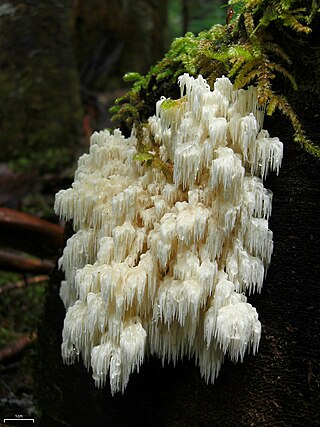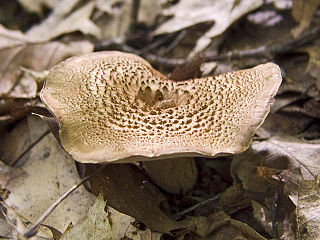
Hydnellum peckii is a fungus in the genus Hydnellum of the family Bankeraceae. It is a hydnoid species, producing spores on the surface of vertical spines or tooth-like projections that hang from the undersurface of the fruit bodies. It is found in North America, Europe, and was recently discovered in Iran (2008) and Korea (2010). Hydnellum peckii is a mycorrhizal species, and forms mutually beneficial relationships with a variety of coniferous trees, growing on the ground singly, scattered, or in fused masses.

Hydnellum is a genus of tooth fungi in the family Bankeraceae. Widely distributed in the Northern Hemisphere, the genus contains around 40 species. The fruitbodies of its members grow by slowly enveloping nearby bits of grass and vegetation. There is great variability in the form of Hydnellum fruitbodies, which are greatly influenced by environmental conditions such as rainfall and humidity, drying winds, and temperature. They are too tough and woody to eat comfortably. Several species have become the focus of increasing conservation concern following widespread declines in abundance.

Phellodon is a genus of tooth fungi in the family Bankeraceae. Species have small- to medium-sized fruitbodies with white spines on the underside from which spores are released. All Phellodon have a short stalk or stipe, and so the genus falls into the group known as stipitate hydnoid fungi. The tough and leathery flesh usually has a pleasant, fragrant odor, and develops a cork-like texture when dry. Neighboring fruitbodies can fuse, sometimes producing large mats of joined caps. Phellodon species produce a white spore print, while the individual spores are roughly spherical to ellipsoid in shape, with spiny surfaces.

Hydnellum aurantiacum is an inedible fungus, commonly known as the orange spine or orange Hydnellum for its reddish orange or rusty red colored fruit bodies. Like other tooth fungi, it bears a layer of spines rather than gills on the underside of the cap. Due to substantial declines in sightings, this species is listed as critically endangered in the United Kingdom.

Hericium abietis, commonly known as the bear's head or the western coral hedgehog, is an edible mushroom in the tooth fungus group. It grows on conifer stumps or logs in North America, producing a cream white fruit body up to 10–75 cm (4–30 in) tall and wide. It fruits from after the start of the fall rains to mid-season.

Hydnellum ferrugineum, commonly known as the mealy tooth or the reddish-brown corky spine fungus, is a species of tooth fungus in the family Bankeraceae. A widely distributed species, it is found in north Africa, Asia, Europe, and North America. The fungus fruits on the ground singly or in clusters in conifer forest, usually in poor or sandy soil. Fruit bodies are somewhat top-shaped, measuring 3–10 cm (1–4 in) in diameter. Their velvety surfaces, initially white to pink, sometimes exude drops of red liquid. The lower surface of the fruit body features white to reddish-brown spines up to 6 mm long. Mature fruit bodies become dark reddish brown in color, and are then difficult to distinguish from other similar Hydnellum species. H. ferrugineum forms a mat of mycelia in the humus and upper soil where it grows. The presence of the fungus changes the characteristics of the soil, making it more podzolized.

Hydnellum compactum is a tooth fungus in the family Bankeraceae. It is found in Europe, where it grows in deciduous forest, typically under beech. Fruit bodies of the fungus grow singly or in groups. They are top-shaped, with convex or flattened upper surfaces up to 10 cm (4 in) in diameter. The surface texture is initially felt-like before becoming pitted and rough in age. The stipe, roughly the same color as the cap, is solid and measures 2–4 cm (0.8–1.6 in) long by 1–3 cm (0.4–1.2 in) thick. On the fertile cap underside are white to purple-brown, curved spines up to 5 mm long. The color is whitish at first but gradually turns dark brown to blackish. Its spores measure 5.5–6 by 3.5–4.5 µm, and feature tubercles that sometimes have a sunken tip. It is considered endangered in Switzerland.

Hydnellum cyanopodium, commonly known as the blue foot or bleeding blue tooth, is an inedible fungus in the family Bankeraceae. It occurs in the Pacific Northwest region of North America.
Hydnellum cyanodon is a rare species of tooth fungus in the family Bankeraceae. Found in Boularderie Island and Antigonish County, it was described as new to science in 1964 by Canadian mycologist Kenneth A. Harrison. The turbinate (cushion-shaped) cap of the fruitbody measures 3–6 cm (1.2–2.4 in) in diameter. Spines on the cap underside up to 5 mm long, and blue in color. The fungus fruits singly or in groups in deep moss under spruce trees.
Hydnellum nigellum is a tooth fungus in the family Bankeraceae. Found in Nova Scotia, Canada, where it grows under spruce, it was described as new to science in 1964 by Canadian mycologist Kenneth A. Harrison. The fruitbodies of this fungus are small, measuring 3–6 cm (1.2–2.4 in) in diameter, and black.
Hydnellum scleropodium is a rare species of tooth fungus in the family Bankeraceae. It was described as new to science in 1964 by Canadian mycologist Kenneth A. Harrison. The fungus has been collected in Tennessee, North Carolina, and Nova Scotia, in both mixed and coniferous forest. Its fruitbody has an irregular, brownish cap measuring 10–25 cm (4–10 in) wide. The sclerotium-like stipe measures 3–9 cm (1.2–3.5 in) long by 2–4 cm (0.8–1.6 in) thick, and roots into the ground. The flesh has a strong, fragrant odor. Spines on the cap underside, blue in color, are up to 11 mm long.
Hydnellum subzonatum is a tooth fungus in the family Bankeraceae. Found in Nova Scotia, Canada, it was described as new to science in 1961 by mycologist Kenneth A. Harrison. Its small fruitbodies grow as fused caps, with individual caps measuring 1.3–5 cm (1–2 in) in diameter. Initially white, they turn light brown with a somewhat darker center, and are faintly zonate. The grayish-blue spines on the cap underside are up to 3 mm long. Growing fruitbodies have an unusual hoary (grayish-white) appearance. The spores are oblong to almost square, measuring 3.5–4.5 by 3.4 µm. The fungus fruits in groups under spruce. H. subzonatum has been collected from Cape Split and Antigonish County.
Hydnellum cruentum is a tooth fungus in the family Bankeraceae. Found in Nova Scotia, Canada, it was described as new to science in 1961 by mycologist Kenneth A. Harrison. Fruitbodies grow singly, in groups, or as fused masses under spruce. Individual caps measure 3–10 cm (1.2–3.9 in) in diameter, and have a club- or cushion-like shape. They are initially light brown, but darken somewhat in maturity. Young fruitbodies can exude droplets of red juice. Spines on the cap underside are lilac to dark blue, and up to 4 mm long. The angular spores are angular, with 4 to 6 unusually prominent outgrowths, and measure 4–4.5 by 3.5–4.5 µm. Harrison described the spores as "so irregular that some resemble stout metal jackstones." The flesh is pale gray to pale brown, and has a strong "medicinal" odor.
Hydnellum multiceps is a rare species of tooth fungus in the family Bankeraceae. Found in Nova Scotia, Canada, it was described as new to science in 1961 by mycologist Kenneth A. Harrison. The fungus has fruitbodies of overlapping and fused caps. Single caps measure 3–5 cm (1.2–2.0 in) in diameter, while fused masses can be up to 30 cm (12 in) in diameter and 8 cm (3 in) tall. The upper cap surface is initially pale brown but darken in maturity. The greyish-brown to dark brown spines on the cap underside measure 2–5 mm long. The fungus has been recorded growing as a partial fairy ring measuring about 20 ft (6 m) in diameter, in spruce woods in Glenmont, Nova Scotia; it has also been recorded from Cape Breton Island. The spores are roughly spherical with sharp processes, and dimensions of 3–4.5 by 3–4 µm.
Hydnellum frondosum is a tooth fungus in the family Bankeraceae. Found in Nova Scotia, Canada, it was described as new to science in 1961 by mycologist Kenneth A. Harrison. Its fruitbodies have caps that individually measure 1.8–4 cm (0.7–1.6 in) across, but can coalesce to create larger fused structures up to 14 cm (5.5 in). The cap surface is greyish brown, with broad whitish margins in age. The spines on the cap underside are small–up to 1 mm long, and extend quite a ways down the length of the stipe. The spore print is fawn; individual spores are roughly spherical and measure 3.5–4.5 by 3–4 µm. Fruit bodies have been found growing near pine and hemlock, in mixed forest of Kings County, Nova Scotia.

Hydnellum scrobiculatum, commonly known as the ridged tooth, is a tooth fungus in the family Bankeraceae. Widely distributed in the Northern Hemisphere, it is found in Asia, Europe, and North America.

Phellodon niger, commonly known as the black tooth, is a species of tooth fungus in the family Bankeraceae, and the type species of the genus Phellodon. It was originally described by Elias Magnus Fries in 1815 as a species of Hydnum. Petter Karsten included it as one of the original three species when he circumscribed Phellodon in 1881. The fungus is found in Europe and North America, although molecular studies suggest that the North American populations represent a similar but genetically distinct species.

Hydnellum underwoodii is an inedible species of tooth fungus in the family Bankeraceae. Found in North America, it was described as new to science in 1906 by American mycologist Howard James Banker. Its reddish-brown, convex to flattened cap measures 5–14 cm (2.0–5.5 in) in diameter. Reddish-brown, partially erect scales adorn the cap surface. Spines on the cap underside are 1–3 mm long; they are initially white, becoming brown with grayish tips in age. The oval to spherical spores are 6–7.5 by 5.5–6.5 µm. The fungus fruits singly or scattered, on the ground in coniferous forests.

Hydnellum joeides is a species of tooth fungus in the family Bankeraceae.
Sarcodon ustalis is a species of tooth fungus in the family Bankeraceae. It was described as new to science in 1964 by mycologist Kenneth A. Harrison, who initially called it Hydnum ustalie. He transferred it to the genus Sarcodon in 1984. It is found in Michigan, where it fruits on the ground in groups under Jack Pine. The type was collected by Ingrid Bartelli in Marquette, Michigan.










